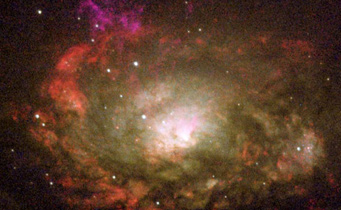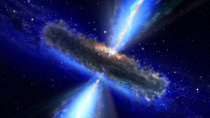Infrared observations of the Circinus Galaxy may help reveal the shape of the dusty region fueling its active galactic nucleus and shed light on what governs dust structures in other galaxies.
The Circinus Galaxy harbors an active galactic nucleus (AGN), a central, compact region (powered by a supermassive black hole) that pumps out more radiation than all the rest of the surrounding galaxy.

NASA / A. Wilson / P. Shopbell / C. Simpson / T. Storchi-Bergmann / F. K. B. Barbosa / M. Ward
Located in its namesake constellation in the southern hemisphere sky about 13 million light-years away from Earth, this galaxy is one of the closest AGN. But by chance of alignment, we will never see Circinus’s bright center directly — this galaxy’s bright heart shines through a veil of thick dust and gas. Astronomers know that most, if not all, AGN contain similar dust structures, but they debate what shape the dusty shrouds take.
Our current understanding of the role such dust plays in an active galaxy’s heart is twofold: dust can serve as a reserve — fuel that’s later dumped on the black hole — or the structure it forms might actually somehow drive the accretion. Scientists need to figure out dust’s geometry, especially on large scales, to be able to glean information from the AGN they enshroud.
An international team of researchers used observations of Circinus from the MID-infrared Interferometric instrument (MIDI) at the Very Large Telescope (VLT) in northern Chile to address the matter. Through data analysis and modeling, the team found evidence of a dust structure with two distinct, perpendicular components, one spread out along the disk and one oblong in the perpendicular direction. This matches some other AGN observations, but the clearly separated components “will require an adaptation of our current understanding of the dust emission in AGN,” Konrad Tristam (Max Planck Institute for Radio Astronomy, Germany) and his colleagues write in their paper.

ESA/NASA, the AVO project and Pa
Traditional wisdom states that obscuring material is shaped like a donut, called a torus. But these structures are so small (on the order of a few light-years at most) that astronomers haven’t resolved one yet. Due to the orientations of these strange dust formations, it is impossible to observe the entire object. So scientists are left with observational data from different angles and viewpoints that create only a piecewise picture of what the dust could look like on larger scales.
However, traditional “dusty torus” theories are waning. “People no longer believe the ‘strict’ unified picture,” writes Keiichi Wada (Kagoshima University, Japan), which states that all AGN should have a torus. Now astronomers know that the obscuring material varies in geometry for different AGN, and the structure should also change with time, notes Wada.
But while some AGN do show evidence of dust tori, there are just as many others that contradict that shape. Circinus is no exception: the research team found hot dust where the “hole” in the donut should be — 80% of the mid-infrared emission seems to come from the diffuse component that’s perpendicular to the compact disk.
Furthermore, both dust structures for Circinus are the same temperature throughout. This uniformity contradicts typical, “centrally heated” AGN dust structures, which have historically been key in many theories. That’s because matter should heat up as it falls toward the galaxy’s central supermassive black hole, radiating heat that warms the surrounding material. So the closer dust is to the black hole, the hotter it should be, just as a person standing near a fireplace is warmer than one standing on the other side of the room. The uniform temperature observed “poses a challenge for the picture of a centrally heated dust distribution,” the team writes.
So the big question is: why is the temperature uniform? The research team remains unsure. “For theorists, like me, their results are exciting,” Wada says. It is a new mystery that, while baffling, opens up new possibilities. Exploring the puzzle may further our understanding of the relationship between dust, AGNs, and the central black holes of galaxies — something astronomers are eager to clarify.
Reference:
Konrad R. W. Tristram et al. "The dusty torus in the Circinus galaxy: a dense disk and the torus funnel"
Astronomy & Astrophysics,vol. 563, March 2013.
 0
0









Comments
You must be logged in to post a comment.